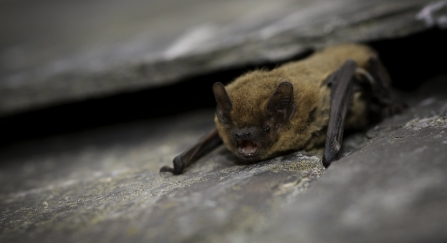Rarely seen at halloween...
The pipistrelle actually hibernates from around mid-October onwards so they're unlikely to make an appearance at Halloween.
One of the bats you’re most likely to see flying around in urban areas. It usually flies between 2 and 10 m above the ground with a rapid, restless, fluttering flight, appearing as a small dark silhouette against the sky (think of the Batman symbol!) with a roughly 20 cm wingspan
Will you record one during the Great Yorkshire Creature Count?

Common pipistrelle bat - Tom Marshall
Why do they make great neighbours for your garden?
You can rely on bats to hoover up lots of biting insects!
Welcoming pipstrelles to your wild patch
Encourage pipstrelles into your garden during and after the Great Yorkshire Creature Count with the following top tips!
1) Give them a home
Put up a bat box! On buildings, put the box as close to the eaves as possible. You can also put them on trees. In general, bat boxes should be installed at least 4 m above the ground to minimise predation by cats, and in a sheltered, sunny location (usually facing in a southerly direction). Ideally situate boxes near hedges and lines of trees which bats use for hunting and navigating.
2) Attract their prey
Plant night-scented flowers to attract moths and other night-flying pollinating insects that pipistrelles will eat
3) For science!
You can become a citizen scientist and count bats for the Bat Conservation Trust’s National Bat Monitoring Programme to help inform bat conservation work.

Common pipistrelle © Amy Lewis
Children of the night...
Pipistrelle populations have more than halved since the 1960s, and many other British bat species have also declined dramatically.
Other important threats include the loss of roosting sites due to conversion and demolition of old buildings, predation by cats, artificial lighting (which can disrupt bats’ body clocks and actively deter bats) and poisoning by chemicals used to treat building materials.
Encouragingly, populations of common pipistrelle and other British bat species have made a partial recovery in recent years, but there is still a long way to go to reverse long-term declines.






